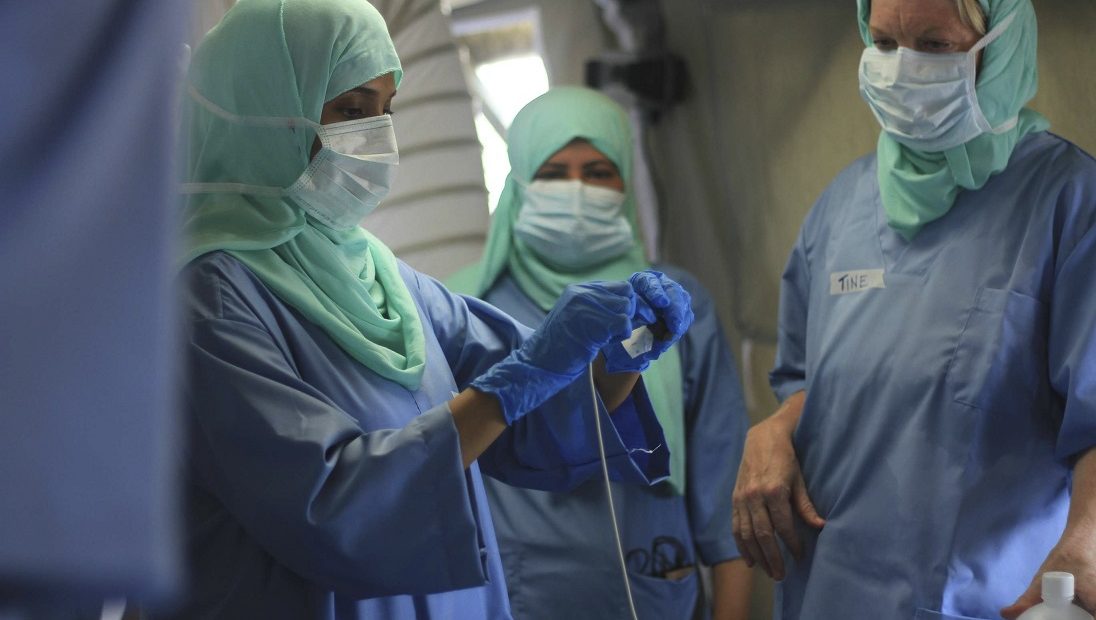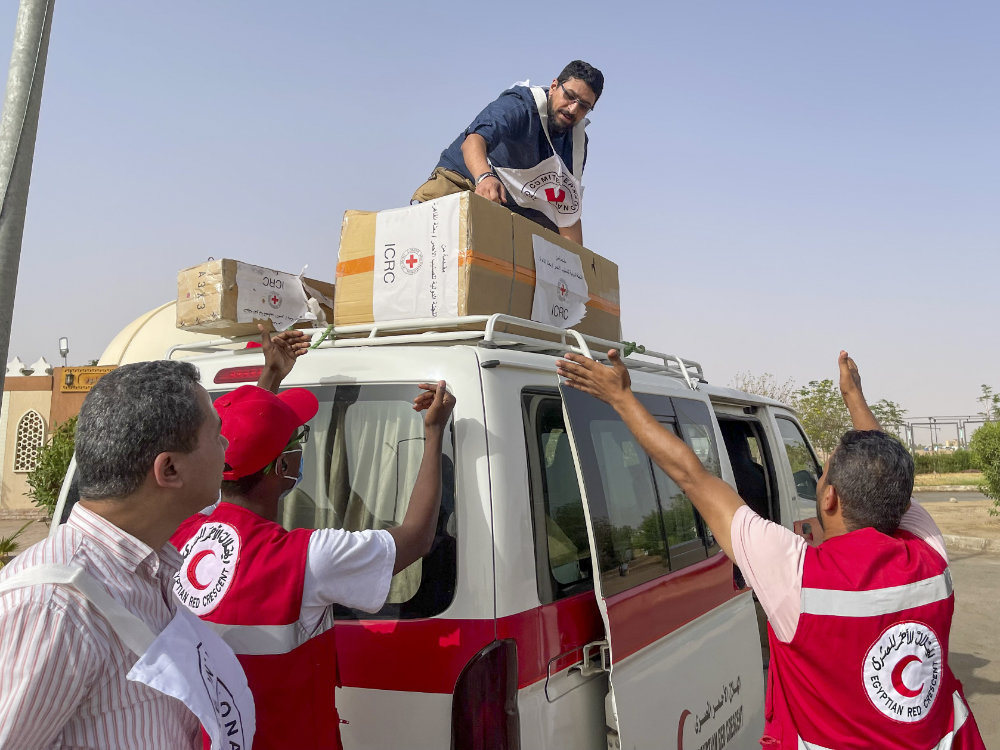Armed conflict and other humanitarian emergencies disrupt health systems in many ways: making healthcare less accessible to people in need; reducing the capacities of the health workforce; weakening health infrastructure and causing the degradation or collapse of other essential services on which health systems depend. Sometimes during conflict, health structures are themselves targeted, increasing the vulnerability of health systems. All this makes addressing pandemic prevention, preparedness and response (PPPR) in such settings extremely difficult, and means that, in reality, responses to the needs of people in these settings continuously fall short. As COVID-19 recedes in memory, it’s vital that the world retains the hard-won lessons of that pandemic and others that came before it, undertaking robust PPPR efforts in all settings – including humanitarian ones – and for all people.
In this post, ICRC’s Head of Health Dr. Micaela Serafini and ICRC Policy Adviser Avigail Shai outline the key issues which must be addressed in global efforts to agree on a Pandemic Accord, in order to ensure that those people most affected by armed conflict and violence are not left behind when – not if – the next pandemic strikes.
The COVID-19 pandemic revealed systemic gaps in pandemic preparedness, prevention and response (PPPR). Now, member states of the World Health Organization (WHO) are negotiating a pandemic accord aimed at dealing more effectively with future pandemics.
It’s vital that in these discussions, the needs of people affected by armed conflict and other humanitarian emergencies are not forgotten. This is not just an ethical imperative; it is also required for epidemiological and socio-economic reasons. All eleven of the Grade 3 emergencies – the most urgent – listed in the WHO’s 2023 Health Emergency Appeal are taking place in such settings. Armed conflict weakens health systems in different ways, leading to suboptimal surveillance and detection capabilities; reducing capacities of the health workforce who may be targeted or displaced; presenting security-related accessibility challenges for the population, staff and/or supplies; and weakening the other services on which health systems depend, such as water, waste management, and energy. It makes populations more susceptible due to lowered immunization coverage, inadequate water and sanitation access, limited nutritional intake and heightened psychological distress. It can also make people potentially more vulnerable to health-related mis- or disinformation. Practically speaking, this means that countries or regions whose health systems have been weakened by armed conflict are often the least able to prevent, prepare for, and respond to outbreaks,[1] and that the outbreaks themselves exacerbate the humanitarian impacts of armed conflict.
A failure to address these easily foreseeable gaps would be unconscionable. That’s why the ICRC offers the following three recommendations for states as they negotiate the pandemics accord.
1. Explicitly including specific populations affected by armed conflict and other humanitarian emergencies – particularly those living under the control of armed groups
Responses to public health emergencies, including pandemics, largely and rightfully revolve around national action led by health ministries. However, this can lead to gaps in PPPR, especially in areas where state-led responses are weak or non-existent, and which are often affected by conflict.
For example, the ICRC estimates that around 175 million people live in areas controlled or contested by some 339 armed groups, 24% of which provide health services to populations. These areas represent a key gap in public-health surveillance, where data is incomplete, not shared, or not gathered at all. Myanmar, south-central Somalia, South Sudan, north-eastern Syria, and parts of Yemen are examples of places where armed groups exert influence or control over some populations, which are effectively excluded from state-led health responses and the state-based global public-health system.
Other populations that risk being left behind include people who are displaced. It has been estimated that in 2022, there were over 100 million people forcibly displaced worldwide, with over 53 million of them remaining inside their own borders. People who have been displaced can face additional barriers to health care, including stigmatization and discrimination, lack of documentation, and sometimes deliberate exclusion for political reasons.
Detainees are another group at risk of exclusion from, or inequitable access to, effective PPPR measures. Responsibility for detainees’ health mostly lies outside the scope of health ministries, often resting with justice or interior ministries, while places of detention (regardless of whether they are situated in areas affected by armed conflict) may not be integrated into national health systems, including when it comes to surveillance, contingency planning, and response mechanisms.
The pandemic accord should explicitly recognise the needs of people living in the above-mentioned situations. At a minimum, these groups deserve equitable access to pandemic countermeasures. While it’s clear that the COVAX Humanitarian Buffer fell far short of expectations during the COVID-19 pandemic, its basic goal of ensuring equitable access to countermeasures to people out of reach of state-led responses is sound. The accord presents an opportunity for states to provide for the establishment of an effective mechanism of last resort, and to set clear requirements that states should equitably share pandemic countermeasures when supplies are limited.
2. Recognizing international humanitarian law (IHL) as a relevant legal regime to guide PPPR
There are currently over 100 armed conflicts involving more than 60 states and 100 non-state armed groups as parties to those conflicts. IHL contains specific obligations relevant to preventing the spread of infectious diseases, maintaining pandemic preparedness, and protecting persons and facilities involved in pandemic response. This means that respect for IHL can play an important role in PPPR efforts. That is why a pandemic accord should explicitly recognize IHL as an existing international legal regime relevant to PPPR,[2] and, where relevant, incorporate IHL obligations, including the following:
Protecting civilian infrastructure needed for pandemic preparedness
IHL aims at avoiding or minimizing harm from military operations in armed conflict to personnel, infrastructure, and services in essential domains like water, sanitation, energy, and healthcare. Respect for IHL rules on conducting hostilities thus helps ensure that essential civilian infrastructure and essential services remain available for supporting efforts to prevent and respond to pandemics[3].
Protecting health workforce, infrastructure, and activities for PPPR
“Prevention of disease” forms part of medical functions under IHL for which medical personnel, facilities, and transports – including those involved in vaccination – enjoy protection from violence or interference with their medical work.[4]
Ensuring sanitary conditions for people detained and displaced to prevent pandemics
IHL contains specific obligations related to the prevention of pandemics. For instance, parties to international armed conflicts detaining prisoners of war (POWs) must take all sanitary measures necessary to ensure the healthfulness of POW camps and to prevent outbreaks.[5] In other detention contexts, in both international and non-international armed conflicts, parties to conflict must take all possible measures to ensure health and hygiene for detainees.[6] Parties to armed conflict must also take all possible measures to ensure that displaced civilians are received in satisfactory conditions of health and hygiene.[7] In occupied territories too, the Occupying Power must, to the fullest extent possible, and with the cooperation of national and local authorities, ensure and maintain public health and hygiene, including taking measures necessary to combat the spread of diseases and epidemics.[8]
Undertaking impartial humanitarian action as part of pandemic response
While states are responsible for public health responses, under IHL, impartial humanitarian organizations have the right to offer their services in order to carry out humanitarian activities, including those related to health response for people in last mile or hard-to-reach areas.[9] For example, in Afghanistan in the 2010s, at the request of the WHO and the then Ministry of Health, the ICRC used its contacts with armed groups to act as a neutral intermediary to negotiate safe passage for polio vaccinators, enabling countrywide vaccination campaigns to resume and vaccination coverage to expand. This offer of services is generally subject to the consent of the parties to the conflict, but it’s the ICRC’s view that those parties must consent to such activities where they are unable to meet the basic needs of populations under their control, including where public-health measures to respond to a pandemic are required.
3. Protecting the health workforce
There was a startling rise in violence against health personnel during the COVID-19 pandemic, and such behaviors have also been observed in epidemics in humanitarian settings. As well as undermining the well-being and safety of health workers, this has negative implications for PPPR efforts. The WHO has outlined important measures designed to protect healthcare,[10] and we’ve described above IHL obligations in this regard. It’s essential that the pandemic accord incorporates obligations and measures to prevent and address violence against healthcare and protect the health workforce, to enable a more comprehensive approach to PPPR.
Conclusion
If the COVID-19 pandemic showed anything, it’s that global health must be a collective endeavour – that no one is safe until everyone is safe. Inaction to strengthen PPPR now is inexcusable – and this includes accounting for the health-related concerns of the hardest-to-reach populations. A pandemic accord that recognises first, the specific PPPR challenges, and the needs of people, in conflict and other humanitarian settings; second, the relevance of IHL for PPPR and finally, the need to protect health workers, will be an important step in strengthening the world’s capacity to ensure future pandemic responses that are fairer, more effective and truly comprehensive.
[1] Frederick Burkle, “Pandemic: State fragility’s most telling gap?” in Patrick M. Cronin (ed.), America’s Security Role in a Changing World: Global Strategic Assessment 2009, Institute for National Strategic Studies/ National Defense University Press, 2009, pp. 105–106; K. Hirschfeld, “Failing states as epidemiologic risk zones: Implications for global health security”, Health Security, Vol.15, Issue 3, May/June 2017, pp. 288-295 ; A.T. Price-Smith, Contagion and Chaos: Disease, Ecology, and National Security in the Era of Globalization, MIT Press, Cambridge, Mass., 2009.
[2] As already recognized in a number of relevant resolutions, see World Health Assembly (WHA) Resolution 74.7 (2021); UNSC Resolution 2565 (2021); United Nations General Assembly (UNGA) Resolution 75/130 (2020); UNGA Resolution 74/306 (2020); UNSC Resolution 2601 (2021); United Nations Economic and Social Council Resolution E/2022/10 (2022).
[3] See Protocol I of 8 June 1977 additional to the 1949 Geneva Conventions (AP I), Arts 48, 51, 52, 54, 57 and 58; Protocol II of 8 June 1977 additional to the 1949 Geneva Conventions (AP II), Arts 13 and 14; ICRC Study on customary international humanitarian law (ICRC Customary IHL Study), Rules 1-24, 54; AP I, Art. 54 (2).
[4] See, for example, First Geneva Convention of 1949 (GC I), Arts 19, 24, 35; AP I, Arts 8(e), 12 and 16; AP II, Arts 9-11; ICRC Customary IHL Study, Rules 25, 26, 28 and 29.
[5] Third Geneva Convention of 1949 (GC III), Art. 29.
[6] Fourth Geneva Convention of 1949 (GC IV), Art. 85; AP II, Art. 5(1)(b); ICRC Customary IHL Study, Rule 121.
[7] GC IV, Art. 49; AP II, Art. 17; ICRC Customary IHL Study, Rule 131.
[8] GC IV, Art. 56.
[9] The most relevant IHL rules include Art. 3 common to the Geneva Conventions; common Art. 9/9/9/10; GC IV, Arts 23, 55 and 59; AP I, Arts 69–71, and 81; AP II, Art. 18; ICRC Customary IHL Study Rules 31 and 32.
[10] Such as these: https://www.who.int/publications/i/item/9789241514347; https://www.who.int/publications/m/item/joint-note-on-means-to-protect-health-care-from-acts-of-violence-in-the-covid-19-vaccination-rollout-in-fragile-conflict-affected-and-vulnerable-settings; https://healthcareindanger.org/wp-content/uploads/2020/05/4469_002_Safer_COVID-19_Response-Checklist_for_Health-care_Services-Lr_1.pdf; Caring for those who care: Guide for the development and implementation of occupational health and safety programmes for health workers.
See also:
- Charles Deutscher, COVID-19 vaccine: three considerations for equitable access within countries at war, March 24, 2021
- Paola Forgione,‘Please, don’t tell anyone!’: healthcare stigma in the COVID-19 era, November 12, 2020
- Cordula Droege, COVID-19 response in conflict zones hinges on respect for international humanitarian law, April 16, 2020







Comments